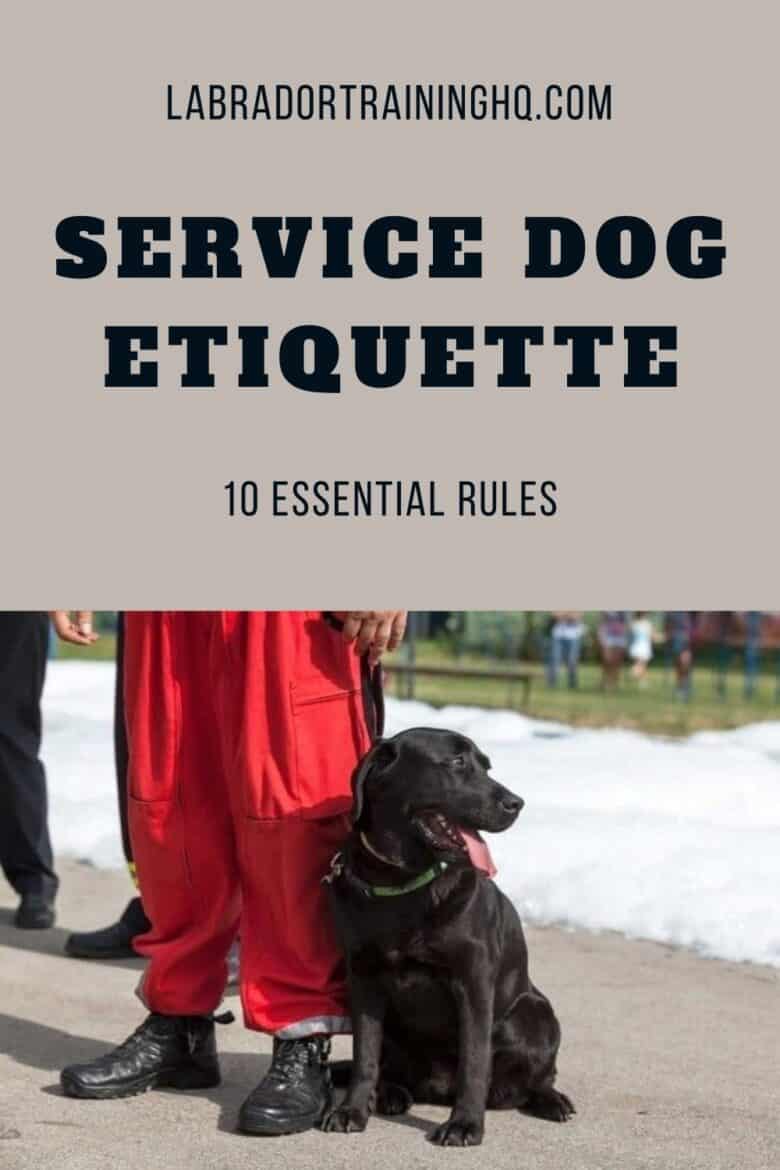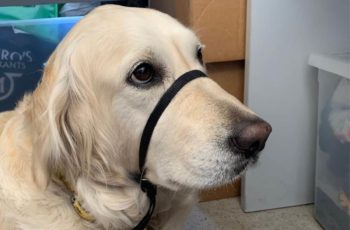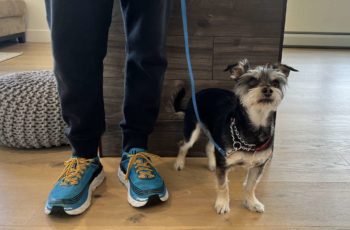This post may contain affiliate links. We may earn money or products from the companies mentioned in this post.
I love service dogs. They are so gorgeous and intelligent, and you have to respect the important role they play in helping some of the most vulnerable people in our society.
So, when you see a service dog in the street, on the bus, or in a restaurant, I understand the urge to go up to them and give them a nice scratch behind the ears.
But that is actually one of the worst things you can do!
When you see a service dog, they are probably “on the job,” fulfilling important tasks to assist someone who really needs them. Touching them or otherwise distracting them can undermine their ability to do those tasks, and put their owner/handler at risk.

Also, it can be a serious invasion of privacy for their owner/handler, not to mention disrespectful if you engage with their service dog before engaging with them, or if you engage with their service dog against their wishes.
We can’t all be experts on service dogs, though, or know instinctively what kind of behavior is and is not appropriate around these special dogs and their owners/handlers.
However, if you follow our 10 essential service dog etiquette rules you should not encounter any trouble. These will enable you to facilitate the work of the service dogs, respect the privacy and dignity of their owners/handlers, and make sure you are complying with the laws around service dogs.
Contents & Quick Navigation
What Are Service Dogs?
Before getting started, let’s just be clear on what exactly services dogs are.
Service dogs are canines that have been specially trained to complete specific tasks to help individual people with a disability or special needs.
Types of service dogs include:
- Guide dogs for the blind
- Hearing dogs for the deaf
- Mobility assistance dogs
- Seizure response dogs
- Mental health service dogs
- Diabetes detection dogs
These dogs are considered essential companions to their owners/handlers and are permitted to accompany them into all publicly accessible sites. They have a variety of other rights that ensure they can accompany their owners/handlers wherever they need.
Specifically excluded from the category of service dogs are emotional support and therapy dogs, which have a more limited range of rights.
You can read more about emotional support dogs here.
10 Essential Service Dog Etiquette Rules
1. Speak To The Owner/Handler, Not To The Dog
When you see an adorable service dog, we can understand the urge to want to approach them, look at them, and engage with them. A lot of people will do this when they see a service dog, even though all of these acts are questionable (as you will see as you keep reading).
But the first mistake that people often make is that they completely ignore the owner/handler and focus their attention on the service dog.
Many owners/handlers will feel that this is incredibly rude. Imagine approaching and engaging with a baby while ignoring the parent/guardian with the baby. Or imagine approaching a couple, and speaking to one person and completely ignoring the other.
In addition to the rudeness factor, it is the owner/handler who knows what kind of work the dog is doing and can inform you if you can engage with them and, if so, how to do so appropriately.
So, if you do have the need to approach an owner/handler and their service dog, always give your attention to the owner/handler first.
2. Do Not Touch Or Otherwise Distract The Dog Without Permission
Remember that when you encounter a service dog with their owner/handler, they are probably working, even if they do not look like they are doing anything.
The dog needs to maintain their focus and concentration on the task at hand, and while they are very well trained, it is possible you could distract them.
It might be easy to think that this is not very important while you are there, as you can assist the owner/handler with anything they might need.
However, firstly, the service dog is specifically trained to know the needs of the owner, detect when their help is needed, and provide help that is useful to the owner/handler and that the owner/handler understands.
Secondly, it may take a while for the dog to regain focus after an interaction with you. So the potentially disastrous consequences of you distracting the dog may only happen much later, when you are no longer present.
So, unless you have been given explicit permission to do so by the owner/handler, do not pet or in any way touch the service dog, or try and get their attention through sound, clicking, or actions.
Also, never praise a service dog, despite the fact that they are doing a wonderful job. Praise and reward are an important part of their training, and you do not want to accidentally send confusing signals.
3. Keep Your Dog A Good Distance From Working Dogs
A potentially much bigger distraction to a service dog than you is your dog! While your dog might understandably be curious about a service dog and eager to engage with them in play, the best thing you can do is keep your dog a good distance away.
Not only can your dog potentially distract the service dog from their work, which is problematic for all the reasons already discussed, but if something unexpected were to happen and the service dog was injured in any way, you could leave the owner/handler without the vital services of their service dog for an extended period of time.
So, if you are out with your dog and you encounter a service dog and their owner/handler, it is best to give them a wide berth.
4. Give Service Dogs Right-Of-Way
When you are keeping your distance from an owner/handler and their service dog, whether you are alone, with your kids, or with your pet, always give the owner/handler and service dog right-of-way and wait for your opportunity to pass.
These service dogs are already doing complex jobs, and giving them the space to do them just makes it that little bit easier. And who doesn’t want to help make the task of a service dog a little easier?
5. Do Not Offer Service Dogs Food
While we have already warned against distracting service dogs, it is worth stating this again when it comes to food, as food is the ultimate distraction, which few dogs can resist, even the best trained.
But service dogs also tend to have fairly regular schedules, including when they eat. This helps them to understand the difference between “work” and “leisure” time, so doing anything to undermine that schedule can also undermine their ability to do their job.
In addition, food-based treats are often used as part of an effective training regime for service dogs. This does mean that giving them treats outside the framework of their training can introduce confusion.
6. Do Not Assume A Sleeping Service Dog Is Off Duty
If you see a service dog sleeping, don’t assume that they are “off-duty” and that the same rules don’t apply.
It is perfectly normal for a dog to react and shut their eyes during down times on the job. Just because they look like they are sleeping doesn’t mean that they are not alert. Anyone who has ever tried to sneak a snack while it looks like their dog is sleeping knows how alert they can be when their eyes are closed.
Never assume that a service dog is off duty, no matter what they are doing (or not doing). Only the owner/handler of the service dog can confirm whether the dog is off duty and if you can engage with them in any way.
7. Seek Out The Owner/Handler If Their Service Dog Approaches You
Service dogs can be trained to perform a variety of different tasks to support their owner/handler. One task that many will have been trained to do is to find help in case of an emergency.
But while the service dog and their owner/handler are trained in what to do in an emergency, other people tend not to be aware of how to respond if they are approached by a service dog without their owner. As a result, many people ignore service dogs in these circumstances, making it difficult for them to find help.
It is pretty rare for a service dog to approach a person alone, so if one does come up to you, bark to get your attention, or follow you, chances are they are looking for help.
So, if you do encounter a service dog without their owner/handler, follow them. They may very well lead you back to their owner, who is in need of some sort of aid or assistance.
8. Treat Owners/Handlers With Respect
Many service dog owners/handlers have reported that the presence of their service dogs seems to make many people feel comfortable with asking them highly personal questions, in particular about their disability.
It is not uncommon for owners/handlers to hear things like: What is wrong with you? Why do you need a service dog? What does your dog do for you?
These are in fact very personal questions that most people would be reticent about asking a stranger, but for some reason the presence of a service dog seems to make many people think that this is OK.
Remember that just because someone has a service dog, they are not signalling that they are comfortable sharing the personal details of their lives with strangers. If the owner/handler wants to open up to you about themselves or their dog, they will.
9. Don’t Feel Bad For Service Dogs
We’ve often heard people say that they feel sorry for service dogs—that rather than living a life split between snoozing on the couch, digging up plants in the garden, and chasing squirrels at the park, they have to work all day.
But this is a misconception. Service dogs have a lot of play time and time to relax, and they receive copious amounts of love from their owners/handles. But this is given at a time that is appropriate.
Moreover, the dog breeds that are chosen to be service dogs are generally people pleasers that love to learn new tasks and have work to do. So, they actually find the role of being a service dog highly fulfilling and satisfying.
So, don’t feel bad for service dogs; they have amazing lives. It is just not something that you can always see when you encounter them “on duty.”
10. Know The Law
Finally, it is a good idea to have some general knowledge about the laws surrounding service dogs so that you don’t accidentally mistreat an owner/handler and their service dog and find yourself on the wrong side of the law.
The first thing to know is that service dogs are allowed anywhere the general public is allowed to go. This includes places that pets are not normally permitted, such as shops, restaurants, or government buildings. This is in contrast to emotional support dogs, where access is at the discretion of the business.
When it comes to private property, it is for the owner to decide whether or not to allow service dog access. However, to deny an owner/handler access to a property on the basis of the presence of their service dog could be viewed as a form of discrimination.
It is also important to be aware that service dog owners/handlers do not need to carry any documentation proving that their dog is a service dog. Moreover, while you are allowed to ask them whether their dog is a service dog and what general tasks they are trained to perform, no one is required to provide information about their disability or explain in any detail why they need the service dog.
Establishments may only ask a owner/handler to remove their service dog from the premises if they appear to be out of control, including not being properly housetrained. Allergy concerns are not a legitimate excuse for refusing a service dog access to any public premises.
Service dogs are not required to wear a vest or anything else that identifies them as a service dog, and owners/handlers are also allowed to manage their dog off-leash. This may be necessary for the task that they fulfill.
Service dogs must be allowed to dwell with their owner/handler in their accommodation, even if the accommodation has a no-pets-allowed policy. The same rules extend to places of business, as a service dog must be able to accompany their owner/handler to their place of employ.
FAQs
Can You Touch A Service Dog?
You should never touch or distract a service dog while they are working as it can undermine their ability to focus on and perform their required tasks. Service dog owners/handlers will play with and give affection to their dogs at appropriate times. You should never touch a service dog unless explicitly invited to do so by their owner/handler.
Does A Service Dog Need To Be With You At All Times?
The American Disabilities Act (ADA) does require that service animals be with their owners/handlers and under their control at all times while in public. However, the dog does not necessarily need to be on a leash, as this may undermine their ability to perform certain tasks.
What Is The Penalty For Faking A Service Dog?
Pretending to be a service dog owner/handler is a misdemeanor that is punishable by a fine of up to $1,000 and six months in prison.
Final Thoughts
Service dogs play an important role in our modern society. These companions can make enormous and profound differences in the lives of the owners/handlers who rely on them.
But how we socialize with service dogs is also very important. These working dogs need to be fully focused in order to be able to perform their tasks, so distracting them can have disastrous consequences.
Many service dog owners/handlers have also reported that the way people engage with their service dogs is sometimes offensive to them and an invasion of their privacy.
While we can’t all be experts in service dogs, if you follow our 10 essential service dog rules, you will be supporting these amazing pups to do their jobs, as well as the health and happiness of their owners/handlers.
Do you have any experience with service dogs?
Share your thoughts with the community in the comments section below.
Save To Pinterest

Top Picks For Our Dogs
- BEST PUPPY TOY
We Like: Snuggle Puppy w/ Heart Beat & Heat Pack – Perfect for new puppies. We get all of our Service Dog pups a Snuggle Puppy. - BEST CHEW TOY
We Like: KONG Extreme – Great toy for heavy chewers like our Labrador Retrievers. - BEST DOG TREATS
We Like: Wellness Soft Puppy Bites – One of our favorite treats for training our service dog puppies. - BEST FRESH DOG FOOD
We Like: The Farmer’s Dog – A couple months ago we started feeding Raven fresh dog food and she loves it! Get 50% off your first order of The Farmer’s Dog.
For a list of all the supplies we get for our new service dog puppies check out our New Puppy Checklist on the PuppyInTraining.com blog.
10 Essential Service Dog Etiquette Rules was last modified: April 25th, 2021 by


